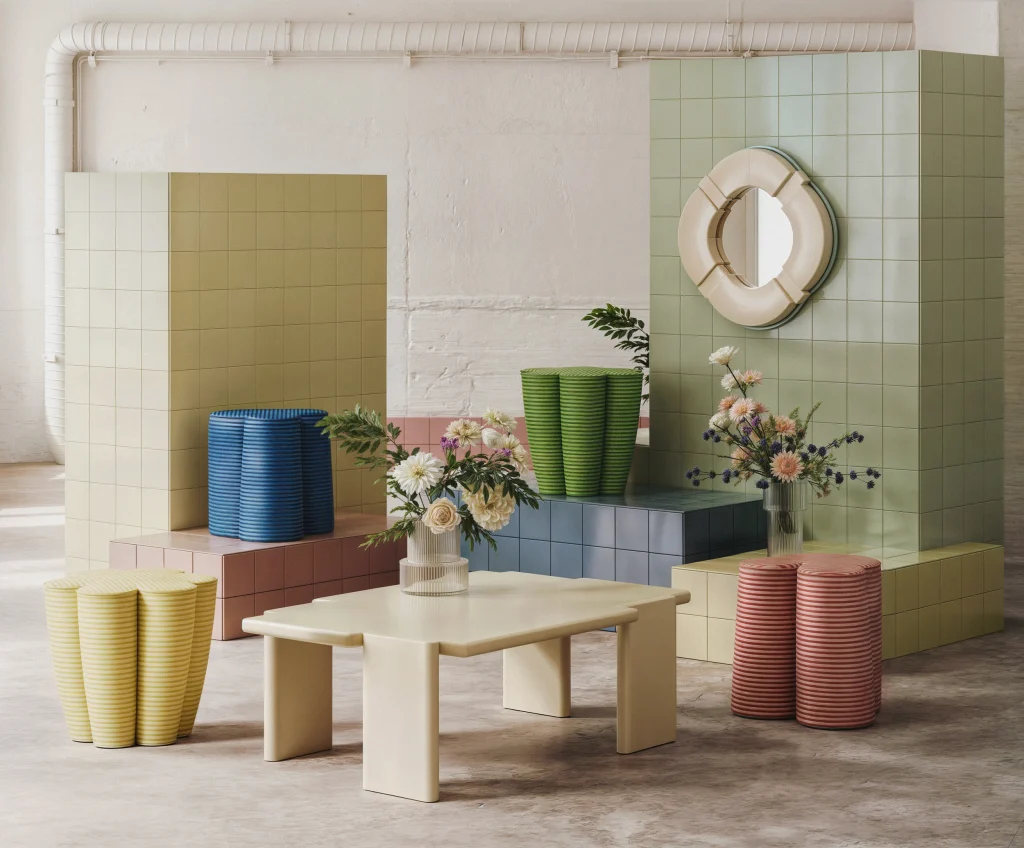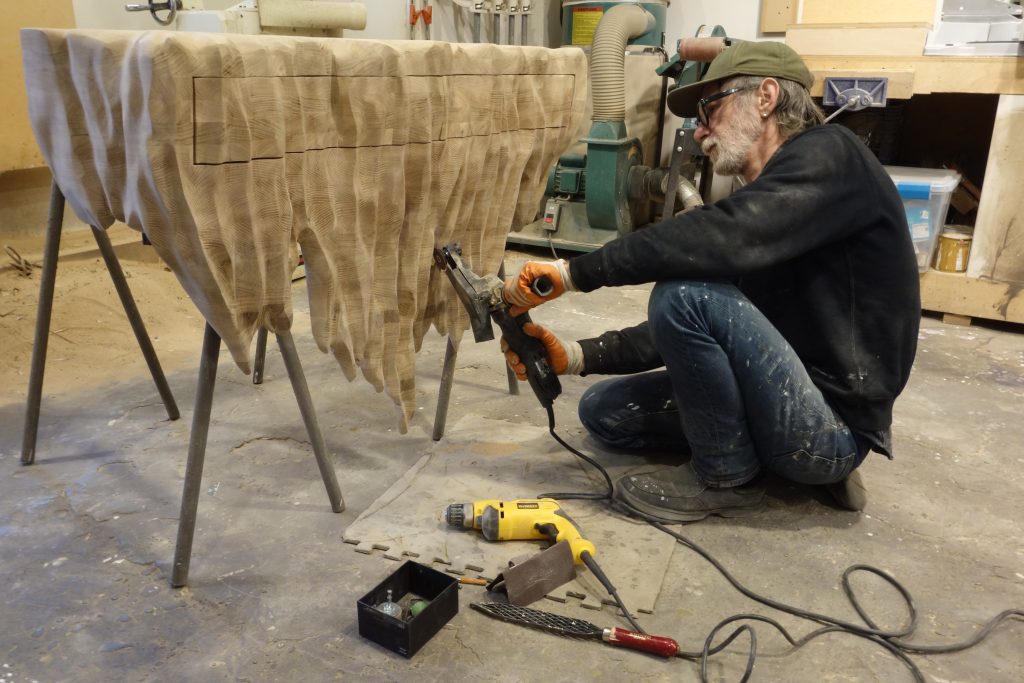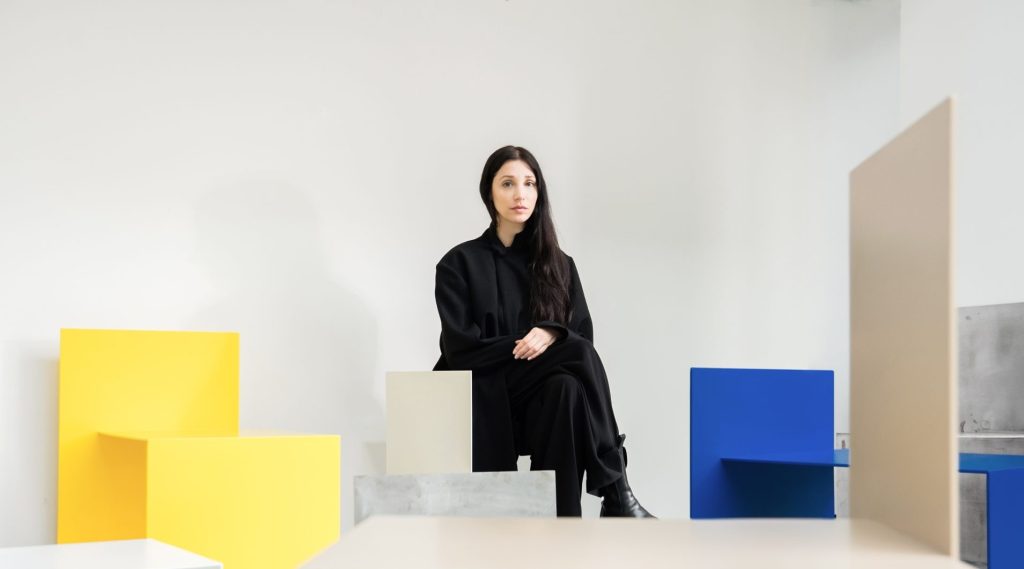
Kiki Goti: A Maximalist, Feminist Way of Living
Distorted archetypal forms sculpted from a combination of contrasting materials meet a distinct modern visual language consisting of stark colour contrasts and a seemingly endless array of strips. These are the defining features of Brooklyn-based designer, architect and educator Kiki Goti’s oeuvre. The maximalist, visceral objects created by the Greek artist evoke an association with liquorice candy, however, her bold homeware is more than mere eye candy. Inspired by Anni Alber’s legendary geometric textiles among others, Goti wants to achieve her feminist design vision of “creat[ing] stimulating, sensorial designs that intrigue the viewers’ curiosity and stimulate their imagination.”
In a similar vein, she wants to break free from traditional notions of domesticity, pathing the way for more inclusive and feminist design. Goti’s “U+II” collection marked the beginning of this feminist reimagination of the home, and with her newest series of works, “I+UU” and “I+I”, she continues this daring project, turning to the concept of artificial nature.
View all pieces by Kiki Goti in her showroom, including the “U+II” Mirror >




“My goal for these pieces was to create sensorial objects that evoke some kind of ‘visual tangibility’. Objects that look tangible. But also ambiguous and mysterious in a playful way. Objects that invite you to interact and engage with them.”
– Kiki Goti






Our living spaces are endowed with meaning and historically speaking, they have been gendered, assigning the realm of domestic life to women. From the Impressionist painter, Berthe Morisot, to modern-day icon, Frida Kahlo, female artists have challenged this view of domesticity. Goti follows the footsteps of these seminal figures given her non-conforming design philosophy. “Ordinary, everyday objects that might be part of a more patriarchal and masculine design approach now become bold statements of a feminine way of experiencing and redefining domesticity,” the Greek designer explains.
This feminist point of view subverts our traditional understanding of how domestic life is supposed to look. Essentially, it defies any expectations: foam is squeezed into shapes mimicking flowers or organic waves with the help of acrylic elements. Clashing, contrasting colours add to Goti’s maximalist, utopian vision of domesticity.








Another fundamental element of Goti’s practice is her emphasis on materiality, which is immensely influenced by her academic background in architecture and her role as an educator at renowned institutions, such as the Pratt Institute. Due to her teaching, she is constantly exposed to creative energy, stimulating discussions, and the most recent innovations in the architectural world, fueling her personal practice. One of the core concepts behind her design process is what she calls “material ambiguity”, which is achieved through the use of different materials, textures and colours.
At the heart of this, is the idea of interactivity. Goti wants her audience to engage with her work, and to be curious and playful in the process. It is not far-fetched to claim that her works do just that as they provide us with a sensory experience. One has the urge to touch and explore the varying textures of the material, to squeeze the foam and contrastingly, to feel the smooth surface of the acrylic. All while taking in the colourful patterns that adorn each structural element of the pieces.










What crystallizes from Goti’s oeuvre is a desire to investigate dualities – from contrasting materials to varying definitions of feminist domesticity – which she labels as “productive paradoxes”. Indeed, Goti seeks out these paradoxes as a source of inspiration and a sort of starting point from which she examines and questions concepts of form, tactility, and space, once again revealing her formal training. Her newest series of lighting, the “I+UU” wall light and floor lamp as well as the “I+I” wall light, illustrates the designer’s continued effort to investigate paradoxes. These works are centred around the idea of artificial nature.
Visually speaking, Goti chose warmer colours compared to the “U+II” collection, making them appear more natural. The paradox at play here is the upcycling of a non-natural, non-recyclable material, foam, which is being sculpted into organic, soft shapes. “The foam is broadly considered a non-natural material. But defining nature is not as straightforward as it seems to be. If humans are part of nature, are the materials that they produce part of nature as well? Is trash part of nature? I have placed some of these prototypes next to my plants in my apartment as a reminder of these questions,” Goti points out.










Above all, Kiki Goti’s work is about the experience itself not only on a visual and tactile level but also an intellectual one. Clearly informed by her academic background in architecture and role as an educator, her works are transfigurations of archetypes into modern, more inclusive design pieces, always keeping in mind how these objects will affect both the space and the user in an emotional way. Goti’s awareness of this relationship between objects and space also explains her motives to challenge outdated ideas of gendered domesticity through material experimentation and bold aesthetics, evident in her “U+II”, “I+UU”, and “I+I” collections.
In the future, she wants to experiment with vastly different materials, wood and upholstered cushions, so it is safe to say that Goti will keep surprising us with new, unexpected ways to challenge the status quo in the design world.
BIO
Kiki Goti is a Greek architect, designer and educator based in Brooklyn, NY.
She is the founder of the design studio Some People, which focuses on playful, interactive architectural installations and public art projects. Because of her background in digital fabrication and material research, she started experimenting with innovative materials and fabrication techniques in furniture scale and in 2022 she launched her first product and furniture design collections using upcycled foam.
As an educator, she has taught at the Pratt Institute, Carnegie Mellon, the University of Pennsylvania and the Parson School of Design. She received her MSc in Integrative Technologies and Architectural Design Research from the Institute for Computational Design at the University of Stuttgart and a Diploma in Architecture from the Aristotle University of Thessaloniki.
She has received several international awards such as an Honorable Mention at the Architecture MasterPrize 2021, a nomination for the Archdaily Building of the Year 2022 and the 1st Prize in AZURE Awards 2018 for Design Excellence, Student Category. She was selected to be part of the Next Progressive Series of ARCHITECT Magazine in 2020. Her work has been published in Sight Unseen, Azure Magazine, design-milk, FRAME, ARCHITECT Magazine, designboom, and archdaily.





